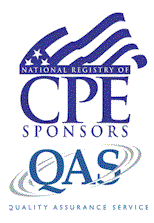Celebrating 25 years serving our friends and customers!
Basic Fringe Benefits - Mini CourseCode: 25-FRINGE2
Add to Cart
Course Details
93 pages
Course description and objectives:
This course is an overview of basic fringe benefits and examines their mechanics, compensation methods, valuation, withholding and accounting. Achievement awards, term life insurance, medical reimbursement, meals & lodging, educational assistance, dependent care, employer-provided automobiles, interest free loans, etc. are identified. Employer and employee economic and tax considerations are recognized. Fringe benefit requirements and limits are specified and ERISA compliance requirements are determined.
Course Objectives:
After reading the materials, participants will able to:
1. Recognize basic fringe benefit planning by determining "income"
under sec. 61, and identify the differences between former nonstatutory
and current statutory fringe benefits created by recent cases, rulings,
and tax law changes.
2. Specify the mechanics of typical fringe benefits, determine the fair market value of a fringe benefit under the general valuation rule or the
special valuation rules, and identify the general accounting rule and the special two-month pour-over accounting rule.
3. Identify an "employee achievement award" under sec. 274, and recognize
the rules for group term life insurance under sec. 79 noting how to
implement proper coverage.
4. Determine the mechanics of self-insured medical reimbursement plans under sec. 105, and specify the requirements of medical insurance
under sec. 106 noting differences.
5. Identify the rules for excluding the value of meals and lodging under sec. 119, and "cafeteria plans" and how they operate.
6. Recognize the requirements and limits of employee educational assistance
programs and dependent care assistance noting how to obtain
each type of assistance.
7. Identify "no-additional-cost services" and determine what property or services are excludable from income as qualified employee discounts
under sec. 132(c), and specify exceptions to working condition fringes and de minimis fringes.
8. Determine the requirements for qualified transportation fringe benefits under sec. 132(f), specify valuation methods for employerprovided
automobiles and, identify the qualifications for the popular physical fitness exclusion, and the requirements and benefits of adoption
assistance programs.
9. Recognize planning services available under sec. 132, 212 and 67, determine
interest-free and below-market loans, identify child care benefits
and corporate funded educational savings accounts, specify S corporation fringe benefits, and identify ERISA compliance requirements.
Presentation Method: Self-Study
Category: Taxation
CPE credit: 4 Hours
Program Level: Update
Prerequisites: None
Advance Preparation: None
Exam expiration date: Participants must submit exams for grading within one year from the date of purchase



